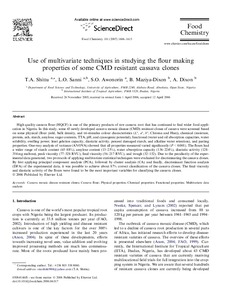| dc.contributor.author | Shittu, T.A. |
| dc.contributor.author | Sanni, L.O. |
| dc.contributor.author | Awonorin, S.O. |
| dc.contributor.author | Maziya-Dixon, B. |
| dc.contributor.author | Dixon, A. |
| dc.date.accessioned | 2019-12-04T11:19:22Z |
| dc.date.available | 2019-12-04T11:19:22Z |
| dc.date.issued | 2007 |
| dc.identifier.citation | Shittu, T.A., Sanni, L.O., Awonorin, S.O., Maziya-Dixon, B. & Dixon, A. (2007). Use of multivariate techniques in studying the flour making properties of some CMD resistant cassava clones. Food Chemistry, 101, 1606-1615. |
| dc.identifier.uri | https://hdl.handle.net/20.500.12478/3452 |
| dc.description.abstract | High quality cassava flour (HQCF) is one of the primary products of raw cassava root that has continued to find wider food application in Nigeria. In this study, some 43 newly developed cassava mosaic disease (CMD) resistant clones of cassava were screened based on some physical (flour yield, bulk density, and tri-stimulus colour characteristics (Lab, Chroma and Hue), chemical (moisture,protein, ash, starch, amylose, sugar contents, TTA, pH, and cyanogenic potential), functional (water and oil absorption capacities, water solubility, swelling power, least gelation capacity, diastatic activity, percent damaged starch, and alkaline water retention), and pasting properties. One-way analysis of variance (ANOVA) showed that all properties measured varied significantly (P< 0.001). The flours had a wider range of starch content (65–88%), amylose content (13–23%), water absorption capacity (136–224%), diastatic activity (128–354 mg maltose), peak viscosity (77–328 RVU), final viscosity (56–217 RVU), and trough (32–152). Due to the peculiarity of the experimental data generated, two protocols of applying multivariate statistical techniques were evaluated for discriminating the cassava clones. By first applying principal component analysis (PCA), followed by cluster analysis (CA) and finally, discriminant function analysis (DFA) of the experimental data, it was possible to achieve about 87% correct classification of the cassava clones. The final viscosity and diastatic activity of the flours were found to be the most important variables for classifying the cassava clones. |
| dc.language.iso | en |
| dc.subject | Cassava Mosaic Disease Resistant Clones |
| dc.subject | Cassava Flour |
| dc.subject | Physical Properties |
| dc.subject | Chemical Properties |
| dc.subject | Functional Properties |
| dc.subject | Multivariate Data Analysis |
| dc.title | Use of multivariate techniques in studying the flour making properties of some CMD resistant cassava clones |
| dc.type | Journal Article |
| dc.description.version | Peer Review |
| cg.contributor.affiliation | Federal University of Agriculture, Nigeria |
| cg.contributor.affiliation | International Institute of Tropical Agriculture |
| cg.coverage.region | Africa |
| cg.coverage.region | West Africa |
| cg.coverage.country | Nigeria |
| cg.isijournal | ISI Journal |
| cg.authorship.types | CGIAR and developing country institute |
| cg.iitasubject | Cassava |
| cg.iitasubject | Plant Breeding |
| cg.iitasubject | Food Security |
| cg.iitasubject | Capacity Development |
| cg.iitasubject | Plant Genetic Resources |
| cg.iitasubject | Pests Of Plants |
| cg.iitasubject | Markets |
| cg.iitasubject | Plant Diseases |
| cg.iitasubject | Genetic Improvement |
| cg.iitasubject | Plant Production |
| cg.iitasubject | Livelihoods |
| cg.iitasubject | Disease Control |
| cg.accessibilitystatus | Limited Access |
| local.dspaceid | 95423 |
| cg.identifier.doi | https://doi.org/10.1016/j.foodchem.2006.04.017 |

